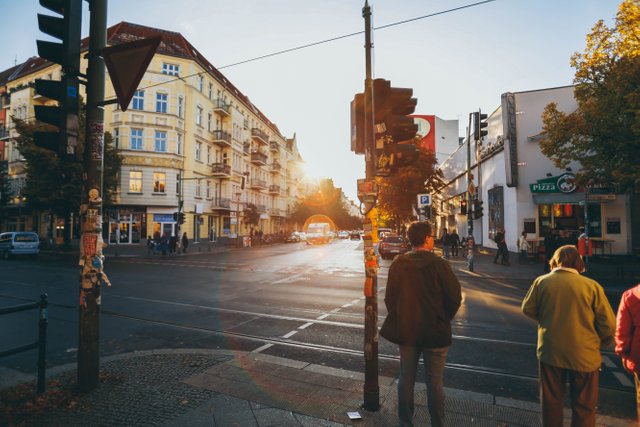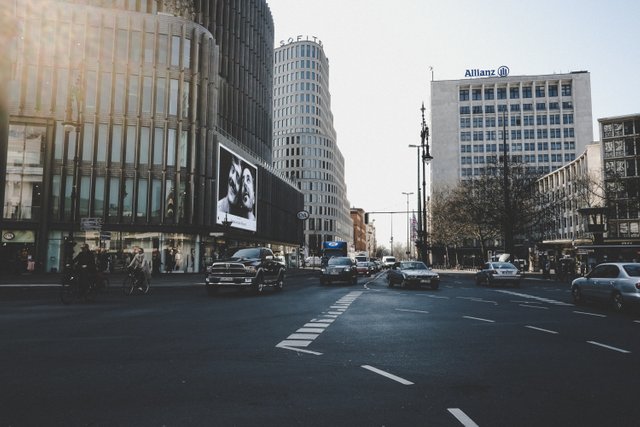Learning German is hard. Expats figure this out pretty quickly once they move to Germany. However, it’s not just the language that makes settling in Germany challenging. Understanding how the German traffic system works can also be tricky. True to German nature it is highly regulated and well-structured. It is also loaded with rules, signs, and vocabulary that expats have to understand and get used to.

Although there is a long list, there are 7 words in particular expats should learn when driving in Germany. Understanding not just the words, but the meaning or concept behind them as well, will make for a much more pleasant driving experience in the country.
Kreisverkehr
Kreisverkehr is the German word for roundabout. Germany has plenty of them and they regularly create confusion even amongst locals. Expats tend to be troubled by them and, due to a lack of proper usage even by Germans, they never quite get what the rules in a Kreisverkehr actually are.
The most important rule is that cars inside the Kreisverkehr always have the right of way. This is why on top of the sign that signals the roundabout (a blue circle with white arrows) sits an additional sign - an upside-down white triangle with red edges, signaling right of way. Contrary to popular belief you do not have to use your indicator when entering the Kreisverkehr. You do have to use it when exiting, however.
Schadenfreiheitsklasse
The term Schadensfreiheitsklasse is not only a tongue twister for expats - it also directly impacts their insurance premium. Car insurance in Germany is fairly complex and includes a mandatory package (called third-party liability insurance), as well as voluntary insurance packages (called partial or fully comprehensive insurance). At its core, however, is the practice of rewarding drivers when they have been accident- or claim-free for extended periods of time. This is called Schadenfreiheitsklasse, or no-claims class. The longer you drive claim-free, the less money you pay for your car insurance. This is about more than just money to Germans. It is a source of pride to boast about one's Schadenfreiheitsklasse to friends and colleagues. The opportunity to lower the car insurance premium by staying accident-free extends to expats registered in Germany as well.
Zebrastreifen
The German Zebrastreifen is appropriately named, given that it refers to the zebra-like white stripes on roads signaling a pedestrian crossing (typically on very busy roads). Germans are very particular about these crossings and do expect cars to stop immediately when a pedestrian approaches the road. Cars do not have to stop at the Zebrastreifen if no pedestrians are present, but are required to do so as soon as one approaches. This does not change, even if there is no specific traffic sign present at the crossing (in this case a blue square with a white triangle, showing a figure crossing the walkway). Even German drivers still get the Zebrastreifen rules wrong at times. That’s mainly due to the fact that the legal requirement to stop for pedestrians at the Zebrastreifen has only been in place since 1996.

Vorfahrt
Who gets to go first? The German concept of Vorfahrt, the right of way, can be hugely confusing to expats when they first move to Germany. Unlike in many other countries, Vorfahrt in Germany is mostly based on “rechts vor links”, meaning “right goes first, then left goes”. Especially at junctions, this is a crucial rule for expats to remember. If you get to a junction and there is no traffic sign specifically indicating (with a white diamond containing a smaller, yellow diamond inside) that you have the right of way, the car, bike, or motorcycle coming from your right always has Vorfahrt - and gets to go first.
Oftentimes expats get confused when they see traffic signs at junctions depicting an upside-down white triangle with red edges. This means that you have to pay extra attention because cars on whatever road you are approaching or about to merge onto, have Vorfahrt. In that case, you’ll have to wait to merge until the street is clear.
Blitzer
A hotly debated topic in most countries are speed cameras - and Germany is no exception. Often called Blitzers, German speed cameras are usually well hidden inside inner-city tunnels, at the bottom edge of large traffic signs on the highway or behind bushes on the side of the road. Getting caught speeding can lead to high fines or even a temporary loss of your driver’s license. A controversial but common practice is the fact that German radio stations are broadcasting Blitzermeldungen (report of speed camera sightings) right after their traffic announcements. The way it works: Listeners call in to report speed cameras they have encountered on their way to work etc, and the radio station will put the message on air to warn other drivers. There are also online tools including maps of Blitzers in your area.
Rettungsgasse
Expats might encounter big traffic signs saying “Rettungsgasse bilden” on the side of roads or the highway. The word Rettungsgasse refers to a rescue alley that drivers are obliged to form. This applies to two common situations: 1) If a driver hears or sees rescue vehicles approaching that are sounding the siren. In this case, the driver is obliged to immediately make room and move to the side, even if the traffic light is showing red or there appears to be only little room to maneuver. 2) On the highway or roads with at least two lanes, drivers are obliged to form a Rettungsgasse if there is a traffic jam or traffic is slowing down considerably. This way rescue vehicles are able to still pass the waiting cars even if traffic on the road or highway has come to a halt.
Learning the basics makes for safer driving
Even if it is hard to learn, understand, and remember some of the German traffic vocabulary, it is paramount that expats driving in Germany at least know the basics. Many accidents can be avoided if the basic rules are followed. Expats moving to Germany and driving for the first time should familiarise themselves with concepts like Vorfahrt and Schadenfreiheitsklasse to make sure they can keep themselves and others on the road as safe as possible.